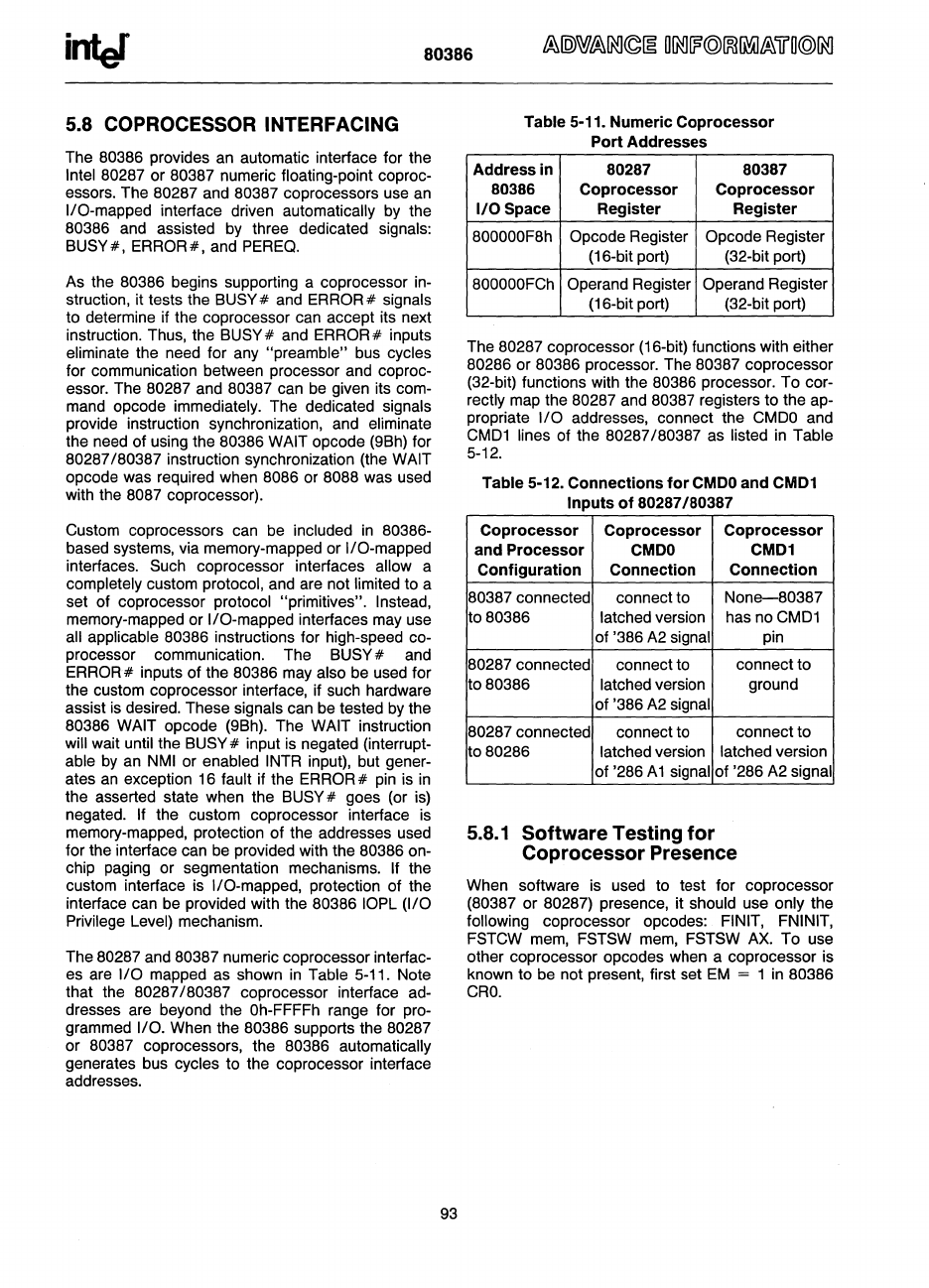
inter
80386
5.8
COPROCESSOR INTERFACING
The 80386 provides an automatic interface for the
Intel 80287 or 80387 numeric floating-point coproc-
essors. The
80287 and 80387 coprocessors use
an
I/O-mapped interface driven automatically
by
the
80386 and assisted
by
three dedicated signals:
BUSY
#,
ERROR
#,
and PEREa.
As the
80386 begins supporting a coprocessor in-
struction, it tests the BUSY # and ERROR # signals
to determine if the coprocessor can accept its next
instruction. Thus, the
BUSY # and ERROR # inputs
eliminate the need for any
"preamble" bus cycles
for communication between processor and coproc-
essor. The
80287 and 80387 can
be
given its com-
mand opcode immediately. The dedicated signals
provide instruction synchronization, and eliminate
the need of using the
80386 WAIT opcode (9Bh) for
80287/80387 instruction synchronization (the WAIT
opcode was required when 8086
or
8088 was used
with the
8087 coprocessor).
Custom coprocessors can be included
in
80386-
based systems, via memory-mapped or I/O-mapped
interfaces. Such coprocessor interfaces allow a
completely custom protocol, and are not limited to a
set of coprocessor protocol
"primitives". Instead,
memory-mapped or I/O-mapped interfaces may use
all applicable 80386 instructions for high-speed co-
processor communication. The BUSY # and
ERROR # inputs of the 80386 may also be used for
the custom coprocessor interface, if such hardware
assist
is
desired. These signals can be tested
by
the
80386 WAIT opcode (9Bh). The WAIT instruction
will wait until the BUSY # input
is
negated (interrupt-
able
by
an
NMI
or enabled INTR input), but gener-
ates
an
exception 16 fault if the ERROR #
pin
is
in
the asserted state when the BUSY # goes (or
is)
negated. If the custom coprocessor interface
is
memory-mapped, protection of the addresses used
for the interface can
be
provided with the 80386 on-
chip paging or segmentation mechanisms.
If
the
custom interface is
I/O-mapped, protection of the
interface can be provided with the
80386
10PL
(I/O
Privilege Level) mechanism.
The
80287 and 80387 numeric coprocessor interfac-
es are
I/O
mapped
as
shown
in
Table 5-11. Note
that the
80287/80387 coprocessor interface ad-
dresses are beyond the Oh-FFFFh range for pro-
grammed I/O. When the 80386 supports the 80287
or 80387 coprocessors, the 80386 automatically
generates bus cycles to the coprocessor interface
addresses.
93
Table
5·11. Numeric
Coprocessor
Port
Addresses
Address
in 80287 80387
80386
Coprocessor
Coprocessor
I/O
Space Register Register
800000F8h Opcode Register Opcode Register
(16-bit port) (32-bit port)
800000FCh Operand Register
Operand Register
(16-bit port) (32-bit port)
The
80287 coprocessor (16-bit) functions with either
80286 or 80386 processor. The 80387 coprocessor
(32-bit) functions with the
80386 processor. To cor-
rectly map the 80287 and 80387 registers to the ap-
propriate
I/O
addresses, connect the
CMDO
and
CMD1
lines of the 80287/80387 as listed
in
Table
5-12.
Table
5·12.
Connections
for
CMDO
and CMD1
Inputs
of
80287180387
Coprocessor
Coprocessor
Coprocessor
and
Processor
CMDO
CMD1
Configuration
Connection
Connection
80387 connected connect to
None-80387
to 80386 latched version
has no
CMD1
of '386
A2
signal pin
80287 connected connect
to
connect to
to
80386
latched version
ground
of '386
A2
signal
80287 connected
connect
to
connect to
to
80286 latched version latched version
of '286 A 1 signal of '286
A2
signal
5.8.1
Software Testing
for
Coprocessor Presence
When software is used to test for coprocessor
(80387 or 80287) presence, it should use only the
following coprocessor opcodes:
FIN
IT,
FNINIT,
FSTCW
mem,
FSTSW
mem,
FSTSW
AX.
To use
other coprocessor opcodes when a coprocessor is
known to be not present, first set
EM
= 1
in
80386
CRO.


















